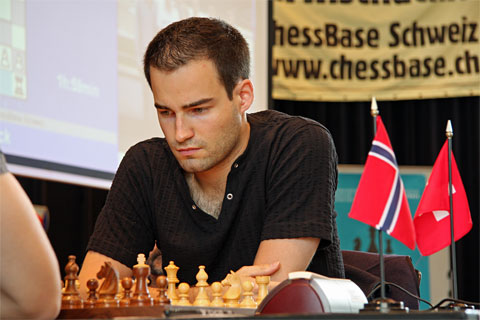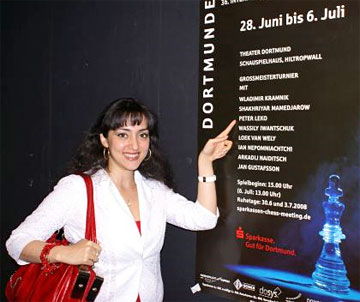Magnus Carlsen - Evgeny Alekseev
Biel Chess Festival
Round 7
Biel
28.07.2008
Good day everyone, welcome to the Chessdom live coverage of Biel International. Alekseev won one game against Carlsen back in the 2004 at the junior event, but all of their recent games ended in draws. It is possible that they will continue discussion in the Queen's Indian defence. Enjoy the game!
1.e4!? No QID this time..
1... e5 Nowadays, on the top level e5 is almost more popular than Sicilian defence. The main reason is that White still haven't found clear ways to achieve advantage against Ruy Lopez Marshall attack.
2.Nf3 Nc6 3.Bb5 Nf6!? Berlin variation, revived by Vladimir Kramnik. It helped him win the World Championship match against Garry Kasparov and other players followed his footprints.
4.d3!? A relatively new approach, adopted from players who hate to play with microscopic advantage in the main line (4.O-O Nxe4 5.d4 Nd6 6.Bxc6 dxc6 7.dxe5 Nf5 8.Qxd8+ Kxd8)
4... Bc5 5.Nc3!? The position now resembles some variations of Four Knights opening, rather than Ruy Lopez. The more flexible solution is to castle and keep the option of playing c3. Carlsen obviously has different intentions. GM Emil Sutovsky liked to play 5. Bxc6 here.
5... O-O It is interesting to point that Alekseev himself played this position with White, last month at the Foros Aerosvit. In the game against Pavel Eljanov, he continued 6. 0-0 and after Nd4 we saw a classical Rubinstein counterattack in the Four Knights. That game finished in quick draw. Mikhail Chigorin played 6. Bg5!?
6.Bxc6!? Carlsen goes another way.
6... dxc6 The pawn structure is similar to the Ruy Lopez exchange variation, but the difference is that Black didn't play a6 and it will be harder for White to prepare d4. On the other hand, Black Knight would be much happier on e7.
7.Nxe5!? Now this is brave! White is picking up the fight before bringing the King into security. Black can play 7...Bxf2+ 8. Kxf2 Qd4+ 9. Be3 Qxe5 or immediate 7...Qd4 8. Be3 Qxe5 9. d4 with dxc5. 7. h3 was safer.
7... Qd4 ( The other capture also looked promising, sample line 7... Bxf2+ 8.Kxf2 Qd4+ 9.Be3 Qxe5 10.h3 Nh5! 11.Qf3 f5 12.d4 Qe8 13.e5 f4 With excellent play for Black.)
8.Be3 Qxe5 9.d4 Qe7 10.dxc5 Nxe4 The last few moves were forced. Now 11. Nxe4 Qxe4 12. 0-0 Be6 causes some problems to White, because Queen has to defend c2 and Black Rooks will quickly grab the open files.
11.Qd4!? Probably better than exchange on e4 because now White could castle long!?
11... Bf5 (11... Nxc3 12.Qxc3 Rd8!? 13.O-O Be6 With idea Rd5-Rad8 would have been equal.)
12.O-O-O Alright! This helps White to protect sensitive c2-pawn and fight better for the d-file (King controlling d1). The drawback is that kingside pawns, that are not protected by the King, might come under attack. Still, White could drop one of them if opening of the files will help in pressuring the Black King.
12... Rad8 13.Qb4 Winning the tempo against b7-pawn. Now if 13...b6, maybe 14. Qa3!? touching on a7? For this reason, 12...Rfd8 might have been more precise.
13... Qe6!? A fine small push that highlights some of the weaknesses in White's camp. The main threat of Nxc3 and Qxa2 forces White to do something about it. 14. Kb1 might not be the best way since White is losing some of the control on the d-file. 14. a3 allows b6 since Queen's desirable square is taken away. Most likely, Carlsen will exchange one or two pairs of pieces to reduce Black's tactical possibilities and continue playing on the structure.
14.Kb1!? Carlsen wants to keep as many pieces on the board as possible. He might not have double Rook's exchange at the disposal, but there are other possibilities. 14...Qg6 is indirectly pressuring on the weak c2. (14.Nxe4!? Bxe4 ( but not 14... Qxe4 15.Qxe4 Bxe4 16.f3 Bd5 17.Bf4! when White is slightly better.) 15.Rxd8 Rxd8 16.Rd1 Rxd1+ 17.Kxd1 with roughly equal ending.)
14... b5 The threat is a7-a5, and after White takes, Black plays Ra8, Nxc3 and takes on a2.
15.b3 This weakening is serious concession. Nc3 might become loose and White will probably trade it soon.
15... Qe5 (15... Qg6!? is posing bigger problems because g2 is also under attack 16.Nxe4 Bxe4 17.Qc3 b4! 18.Qc4 Qxg2 19.Rhg1 Rxd1+)
16.Nxe4 Bxe4 17.Bd4 Qf5 18.Qc3 18. Rd2 was also fine. The position is now completely equal.
18... f6 19.f3 Bd5 20.Rhe1 ( The daring pawn hunt with 20.Qa5!? allows Black to gain nice counterplay 20... Bf7 21.Rhe1 (21.Qxa7? Bg6 and Rd4) 21... Bg6 22.Rd2 Qf4 or Rd7)
20... Rd7 Both players will spend a couple of moves on solidifying the position. Alekseev wants to double the Rook and maybe transfer the Bishop to g6, while Carlsen will play Kb2 and move the (in some positions hanging) Bishop from d4.
21.Bf2 Rfd8 22.Rd4 h5 Taking g4 under control and giving some air to the King. The Bishop will probably move to g6 in the future.
23.h3 Is he insisting on g4? It is possible that Black will face the "how to improve beautiful position" paradox that was so nicely explained in books of GM Suba.
23... Bf7 24.g4 hxg4 25.hxg4 Qg5 Some progress here, Queen was forced away from the ideal diagonal.
26.Kb2 Rxd4 27.Bxd4 Qd5 28.Rd1! Exclamation mark only because White is not afraid to go under the pin. With Bishop on d4, f4-g5 might be a good plan. The alternative was 28. Bf2...
28... b4! Excellent reaction. Trying to drive the Queen from this diagonal and swap b-pawn for very important f3.
29.Qxb4 (29.Qe3!? Re8 30.Qf4)
29... Qxf3 30.Rd2 Idea is 30...Qxg4 31. Bc3!? (30.Rg1 allows Queen's trade after Qe4.)
30... Qxg4 31.Bc3 Qc8 32.Rg2 Bd5 The certain pressure against Black King is compensating for the pawn deficit.
33.Rg1 Qf5 Maybe chance for Qb7?
34.Qb7 Kf7 35.Qxc7+ Another possibility was to take a7-pawn and push the passer sometime in the future. Obviously, Carlsen wanted to have his Queen near the enemy King.
35... Rd7 36.Qc8 Be4 The only move! Allowing Qh8 would have been very dangerous. Now Black will have Qh7.
37.Qh8 Qh7 38.Qc8 Qf5 39.Rf1!? Qe6!? (39... Qxf1 40.Qxd7+ Kf8 looks like a draw (40... Kg8? 41.Qe8+ Kh7 42.Qxe4+))
40.Qh8 Re7 The show goes on...
41.Rd1 Re8 42.Qh2 Bf5 43.Rd2 (43.Rd6 allows 43... Qe2 and Magnus wants those heavy pieces on the board.)
43... Re7 44.Qb8 Rd7 It was about time Alekseev to try exchanging the Rooks and soften c2 defence. But this might not be the best way to do it, since White has 45. Rd6 and then Qe2 is met by Rxd7 (which was not possible in the line given above).
45.Rf2 Bg6 46.Rh2 Qe8 (46... Qe4!?)
47.Qg3 Qe4 This is the best square for the Queen. It protects Bg6 and attacks on c2.
48.Rg2 Re7 49.Rd2 Rb7 Odd-looking move, but it doesn't change the assessment. Still dead equal.
50.Qh2 Re7 51.Qb8 Bf5 52.a4 Finally, a pawn is moved :) It is hard to make any progress though, as long as Alekseev is firmly pressing on c2.
52... Bg6 53.a5 Bf5 54.a6 Bg6 55.Qg3 Bf5 56.Rg2 Bg6 57.Rh2 Bf5 58.Qb8 White is trying to sneak in through the 8th rank, but even simple Kg6 keeps Black intact.
58... Bg6 59.Ka3 Bh7 60.Rd2 Bf5 61.Qh8 Qe3 62.Kb2 Qe4 63.Rf2 Qg4 64.Qh2 Bg6 65.Qd6 Qe6 66.Qxe6+!? Kxe6 67.Ba5 The Queens have left the board, and this is now interesting endgame. White might be planning to check on e2, trade the Rooks and play Bb6.
67... Be4 Covering the possible check and taking c6 under protection.
68.c4 g5 It is too early to speculate who will be faster in this race, but Black pawn have a clear road ahead...
69.Bd2 Rg7 70.Re2 f5 71.b4 g4 72.b5 cxb5 73.cxb5 g3 74.Re1 Hoping to block the promoting square. Immediate 74. b6 was also interesting, White sacrifices Bishop for pawn, but his own pawns are very close to promotion.
74... Kd5 75.Be3 Probably immediate b6 was better.
75... Bd3! Exactly, now Black grabs the advantage.
76.Rd1 Ke4 77.Rxd3 Kxd3 78.Bg1 f4 79.b6 f3 80.b7 Rg8! This is the crucial tempo, White has to push c-pawn, but it's too late...
81.c6 f2 82.c7 fxg1=Q 83.c8=Q Qd4+ 84.Ka2 And Carlsen resigned seeing that 84... Rxc8 and 85...Qc4+ is winning for Black. An odd game, where nothing happened for about 30 moves and then White decided for a sudden pawn race. Black turned to be faster because his pawns had no obstacles on the way. Thank you everyone for following Chessdom live commentary, see you again tomorrow at 14:00 CET.
0-1













































